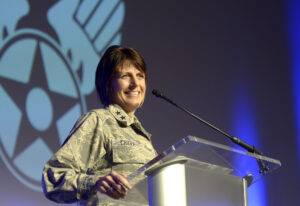Space Force technology roadmap to emphasize role of private sector
By Sandra Erwin

WASHINGTON — The U.S. Space Force is putting together a technology wish list and will need help from the private sector to make it a reality, said Maj. Gen. Kimberly Crider, the acting chief technology and innovation officer for the Space Force.
“We’ll be publishing soon our 2020 science and technology challenges,” Crider said Aug. 19 at the Ascend virtual conference hosted by the American Institute of Aeronautics and Astronautics.
Crider is a reservist who was the Air Force’s chief data officer before she was tapped by the head of the Space Force Gen. John “Jay” Raymond to help stand up the service’s technology and innovation office.
The Space Force science and technology roadmap, Crider said, will echo findings from a July report issued by the Defense Innovation Unit and the Air Force Research Laboratory, “State of the Space Industrial Base 2020: A Time for Action to Sustain U.S. Economic & Military Leadership in Space,” which calls for greater government and industry collaboration to advance the space economy and national security.
“We agree with the industrial base report,” she said. “We have to coordinate with industry and other government leaders.”
A key goal is “ensuring that we have a strong industry base and that we can influence policy effectively to ensure we have the capabilities that we need,” said Crider.
The Space Force supports the idea of “building unity of effort across government, industry and academia to incentivize that industry base,” she said. Technologies in areas like satellite-based communications, navigation, positioning and timing are examples of capabilities “we all rely upon, not just the military,” Crider said. Another example is space transportation and logistics, she said, as systems being developed for NASA could be leveraged by the Space Force.
Generating electricity or other forms of power in space for use in space and on Earth is another “very important technology area, and important for us to continue to look to our industry base to develop,” said Crider.
Raymond in the introduction to the 2020 State of the Space Industrial Base report noted that the findings and recommendations do not represent the official position of the U.S. Space Force or any other branch of the government. However, “it is important that we listen to these insights and evaluate the feasibility of implementing them in the advancement of national interests,” Raymond wrote. “America’s future in space is a partnership and, as with any partnership, communication is key.”
As acting chief technology and innovation officer, Crider reports directly to Raymond. She said she is only in the job temporarily until a permanent CTIO is named who will be a civilian from the Senior Executive Service.
During a Q&A session, AIAA event coordinator Tobey Jackson asked Crider what she considered the biggest myths about the military’s new space organizations, the Space Force and U.S. Space Command.
“Well, there’s certainly the myth that we don’t need these two things and I hopefully I helped to dispel that a little bit,” she said.
It’s a fact that commanders across all U.S. combatant commands rely on space, Crider said. Without access to space, there is no access to information and other capabilities, “so it’s critical to everything we do.”
August 20, 2020 at 02:26AM
via SpaceNews read more...

Post a Comment